#Sam Arkoff
Text
Since it's summertime, I thought it'd be fun to take a look at a bygone movie subgenre: the beach party films of the 1960s. This video from the YouTube channel "The Royal Ocean Film Society" will tell you all about it.
youtube
#movies#film history#beach party#american international pictures#1960s films#Sam Arkoff#roger corman#frankie avalon#annette funicello#teen films#movie marketing#beach movies#Youtube#muscle beach party#bikini beach#beach blanket bingo#ghost in the invisible bikini#pajama party#catalina caper#summer#1960s vintage
5 notes
·
View notes
Text
Frogs

A very young Sam Elliott paddles through a swamp taking pictures at the start of George McCowan’s eco-horror THE FROGS (1972, Prime). With the first shot, the frame freezes on two large lizards with the names of AIP’s founders, James H. Nicholson and Samuel Z. Arkoff, superimposed over them. At first, I thought someone was slagging the executives, but all the credits play over freeze frames of various noxious critters, litter and pollution, so unless someone hated everybody working on the film, I guess that wasn’t the case. Nonetheless, any time those two lizards turned up, it seemed the money men were on set making sure nobody was wasting money. At times, they even helped kill off various characters, possibly so they could stop paying them. But that’s enough whimsey for now. The film depicts the animal kingdom revolting against humanity after years of abuse. Its heart is in the right place, but its brain is nowhere to be found. A boating accident leads to nature photographer Elliott’s staying with ruthless tycoon Ray Milland’s family during a reunion celebration, but the script is so inept it takes forever to establish the blond young man (David Gilliam) always by Milland’s side is his grandson and not some random boytoy. For that matter, it’s hard to keep clear which characters belong to which parents. Most of the deaths are laughable, but dotty Aunt Iris (Hollis Irving), done in while hunting a butterfly for her collection, actually works, as the creature leads her deeper and deeper into the swamp, and she becomes progressively disheveled. Some of the actors — Elliott, Joan Van Ark (in her film debut), Judy Pace and Nicholas Cortland — do decent work within the limitations of the inane script. Milland snarls his way through until almost the end, and Lynn Borden whines so much as his daughter-in-law it was a mercy to the audience she was finally done in by a large tortoise. The film has good atmospheric photography by Mario Tosi, though there are times the footage cuts between day and night with no logic. And Les Baxter creates an eerie score with random notes that seem inspired by the sound score for Alfred Hitchcock’s THE BIRDS (1963). Of course, this is an obvious attempt to up the ante on that film. Sadly, the ad campaign didn’t warn us “THE FROGS is coming,” but they did advise, “If You Are Squeamish Stay Home!!! Cold green skin against soft warm flesh…a croak…a scream.” The scream, I fear, would mostly likely be from laughter.
1 note
·
View note
Photo

#james nicholson#sam arkoff#american international pictures#aip#halloween#halloween 2020#countdown to halloween#horror
2 notes
·
View notes
Photo








ɪɴᴠᴀsɪᴏɴ ᴏғ ᴛʜᴇ sᴀᴜᴄᴇʀ ᴍᴇɴ (1957)
#invasion of the saucer men#1957#paul blaisdell#american international pictures#aip#james h. nicholson#samuel z. arkoff#sam arkoff#1950s#50s#50s monsters#50s monster movies#cinema#film#saucer men#invasion of the saucer-men#science fiction#horror
166 notes
·
View notes
Photo



1964 - Sam Arkoff delivers the keynote speech at the Texas Drive-In Theatre Owners Association Convention in Dallas
10 notes
·
View notes
Text
“You Devilish Mummy!”: Mexican Horror in America, 1958-1963

Rosa Arenas
For some people, Cinqo de Mayo means a nacho party platter, a cooler full of Corona, plastic sombreros and a pinata filled with stale butterscotch discs. For a few of us, though, Cinqo de Mayo means one thing and one thing only: Aztec mummies. The sad part of it is that it might actually make much more sense than the nachos.
After Tod Browning and his crew left the set at the end of the shooting day while working on 1931’s Dracula, they were replaced by director George Melford and a Mexican cast and crew. Using the same sets, the same cameras, and a translated version of the script, they worked all night to shoot the Spanish-language version of the film. Those who have seen both tend to agree that the Spanish version is the superior of the two. The cinematography is more vibrant and less stage-bound than the Browning version, the atmosphere is richer (possibly because they were shooting at night), and most important of all, the Mexican Dracula (Carlos Villar) smolders with a sexual energy and menace Bela Lugosi, great as he is, lacks.
Prior to the mid-’50s, most American audiences would probably be surprised to learn that Mexico even had its own film industry. That’s when low-budget producers from Sam Arkoff on down recognized the economic advantages of snapping up the US distribution rights to existing foreign genre pictures. It made perfect sense. You didn’t need to hire any directors or cameramen or gaffers. There were no actor hissy fits to smooth over. All you needed to do was dub in some English dialogue that more or less made sense, fit the action on the screen, and approximately matched the actors’ lip movements. Or maybe not, whatever. Sometimes you might want to bring in an editor to try and rearrange a few scenes so the picture and dialogue’ll make more sense to the kids at the drive-in, but even that wasn’t always necessary. Come up with a snappy English title, Americanize some of the actors’ names, and you’re good to go. The important thing is these films could be picked up for a song, and minus a few minor expenses everything they brought in was gravy.
Suddenly US theaters were full of sci-fi, horror, and westerns from Italy, Japan, Spain, and yes indeed, Mexico. Low-budget distributor K. Gordon Murray quickly established himself as the king of marketing Mexican horror cheapies to American audiences, handling films like The Man and the Monster, The Brainiac, Curse of the Doll People, and a whole lotta movies with “Aztec Mummy” in the title. It would be nice to say these films have complex and thought-provoking storylines, that the acting is strong and subtle, that the cinematography is dazzling and the special effects on a par with any major American studio at the time, but that would really be pushing it. A lot of the films were just slapdash, flat-footed remakes of popular American films but with cheaper sets. A few of them do stand out, though, in that even the dubbed and edited versions remain uniquely Mexican, even if they do seem to tell the same story over and over again. And some of them are just plain nuts.
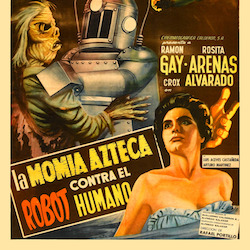
Genre director Rafael Portillo and screenwriter Alfredo Salazar were best known for their Aztec Mummy and wrestling pictures, and in 1958 topped even Santo Meets Dracula with La momia azteca contra el robot humano, translated as The Aztec Mummy Against the Humanoid Robot or, more simply, The Robot Meets the Aztec Mummy.
As the opening narration assures us, the film is based on an “actual experiment” conducted by two scientists from “The Los Angeles University” and verified by witnesses who “signed sworn statements with a notary public” so “there is no question about this story’s authenticity.”
Please keep that in mind.
The film is told mostly in flashback and through voiceover, which is generally a sure sign you’re watching a heavy-handed bit of editorial butchery. The same sort of thing was done regularly to the US versions of Toho films, usually with a mind toward simplifying the story.
Okay, a psychiatrist (Ramón Gay) is mocked by his colleagues when he presents a paper about past life regression, so he storms home and hypnotizes his wife Flora (Rosa Arenas). We slip into a low budget flashback within a flashback as we learn Flora was once an Aztec maiden on schedule to be sacrificed when she runs off with a warrior. The village priests find them, bring them back, and bury the warrior alive after placing a curse on him. Then they fit the old Flora with a gold bracelet and breastplate inscribed with directions to the location of “the secret Aztec treasure.” Then they cut out her heart, which may say something about the effectiveness of that breastplate.
Returning to the first flashback, we learn the evil Dr. Krupp had spied on the experiment and now wants in on it. Nevertheless the good doctor decides for some reason that the best way to prove his theory is to find the bracelet and breastplate, so they all go looking. Lucky for them they find a secret passage under the pyramid that I guess is in their backyard. Moments later they find the ancient temple, the skeleton of the old Flora, and the breastplate which they take home with them. The fun doesn’t last long, though, as the warrior’s mummy shows up at the house, grabs the breastplate, grabs Flora, returns to the temple, and prepares to cut out her heart again. At this point we’re about six minutes into the film.
Then it turns out, see, that Dr. Krupp is really a sinister underworld figure known as The Bat, and...oh screw it. Over the course of the rest of the film we get gangsters, a shootout, hypnotism, a mad scientist, a pit full of rattlesnakes, that mummy again, some Aztec rituals, a few vanishing bodies, a police investigation, a stolen corpse, a stolen brain, and a stolen “machine that uses radium,” together with lines of dialogue like, “oh, you devilish mummy!” and “continuing our search we hurried to the snake pit.” Eventually we even get a robot there near the end (though it’s more of a reanimated corpse wearing a metal suit festooned with some blinking lightbulbs),and it has a brief and slow wrestling match with the mummy.
And all of it, believe it or not, is crammed into a zippy 65 minutes. No, it’s not a particularly good film as the term is traditionally used, but it is a fascinating one. As crazy as it all gets, as big as some of the plot holes and lapses in logic may seem, the craziest thing of all is that you can’t really criticize it for any of that given that it’s, y’know, based on a true story.
Robot Meets the Aztec Mummy is a pretty extreme example of what was coming out of Mexico at the time. Other genre pictures were no less strange, maybe, but a little more sane.
Three years after Bert I. Gordon’s Attack of the Puppet People and 25 years after Tod Browning’s The Devil Doll, Benito Alazraki released his 1961 film Muñecos infernales, better known in the States as Curse of the Doll People.
An archaeologist interested in ancient rights and such and her physician husband (Ramon Gay again) visit an art collector friend who regales them with the exciting tale of his recent trip to Haiti. While there, see, he and two friends witnessed a secret voodoo ritual that included human sacrifice. For all the crazy goings on though, the art collector couldn’t take his eyes off the idol the voodoo priests were worshipping. He thought it would make a fine addition to his collection, so the next day he went back and stole it.
(Given that the story is not told in flashback, just by some guy sitting in an easy chair, I’m tempted to think the whole Haiti angle was an invention of the screenwriter for the American version. Maybe the producer was a little tired of Aztecs by this point.)
It’s not hard to guess that stealing a revered idol from a voodoo temple is not without its repercussions, and sure enough before you know it the children of all the men on the Haiti trip start receiving new dolls in the mail. Real nice, realistic-looking ones too. None of the parents seem a bit concerned by the arrival of anonymous gifts for their children, merely handing the dolls to the tykes and sending them off to bed. After a few cuts to an oddly Mexican-looking Haitian voodoo priest, well you guessed it. the dolls start coming to life and knocking off the parents in ways that can’t easily be traced back as the work of an evil dolly.
The one surprise here is given the budget, the special effects (midgets in doll clothes on oversized sets) are really, really good. Better than Bert Gordon’s, even. It’s just too bad the story around them doesn’t have a bit more zing to it. It’s a little flabby and obvious. Still, you start to get the sense a pattern is developing.
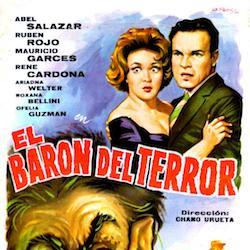
El baron del terror (released in the States as The Brainiac in 1962), directed by Chano Urueta, marked a bit of a break from the simple revenge plot. Oh wait, no it didn’t. But it was still a break from the standard storyline.
As the film opens it’s 1661, a comet has appeared in the sky, and an evil baron (Abel Salazar) is being burned at the stake by Inquisitors for practicing black magic. As evil barons are so wont to do when finding themselves in circumstances like that, he places a curse on all those who condemned him, vowing he would return in 300 years when the comet reappears and kill off all their descendants. The Inquisitors, for some reason, don’t seem terribly concerned by all this and go ahead and burn him anyway.
Cut to three hundred years in the future and true to his word the comet has reappeared and so has the baron, who starts snuffing people who didn’t even know they were related to Inquisitors. Yes, it’s a plot we’ve seen how many times already? But the Brainiac, as the title might hint, does offer a twist or two. First, before he kills his victims the Baron transforms into a kind of hideous horned demon monster (the doll special effects were better). Then during the murders he sucks out his victims’ brains, which he keeps in a big salad bowl in the kitchen. When he lures someone over to his apartment and confirms their identity, all he needs to do is excuse himself to the kitchen for a moment, have a spoonful of brains, and shazam. No more descendant and more brains for the baron.

A year later Ueueta returned to more standard form with La cabeza viviente, aka The Living Head. Here again he opens with a long prologue in which he went to some pains to at least give the illusion of historical accuracy. When a great Aztec general dies, not only is he buried, but so are a few of his servants and a high priestess to help him on his way in the afterlife. That those others weren’t quite dead yet doesn’t seem to matter much. It’s all quite a big to-do.
Cut to 450 years in the future, as an incredibly bad archaeologist and two assistants stumble upon the tomb. First they completely destroy the mummy of the high priestess and shrug it off. Then when he finds the invaluable Ring of Death, the archaeologist immediately announces that he’s going to give it to his daughter, “who likes ugly things like that.” Then after reading aloud the very clear curse that will befall anyone who desecrates the tomb, the trio scurry’s off with the general’s mummified head and the mummy of his servant (the one still clutching the knife). Do they then deliver them to the museum where they can be properly cared for and kept in carefully climate-controlled environments? Well, almost: he brings them back to his apartment and keeps them in the living room.
Yeah, it’s not really hard to see where this is headed. The daughter starts wearing the Ring of Death and gets a little kooky in the head . Then the servant and head come to life and all three of them (the daughter carrying the head) go tracking down the desecrators in order to cut out their hearts.
“I know what you’re thinking,” a police inspector says after the first murder. “But I don’t believe in legends. Or in superstitions either. All I know is that this is a very difficult case.”
That’s the real killer in The Living Head. Even more so than most, the dubbing is miserable, with most of the lines either being non-sequiturs, or so plainly obvious and logical they come out sounding like non-sequiturs. I get the feeling sometimes that the voice actors they brought in were never given scripts, simply shown the film and told to make it up as they went along.
Ah, but this is merely a taste of what’s out there in terms of Mexican horror. We haven’t even considered the Santo pictures yet, and there are hundreds of those. I’m not sure if the likes of Robot Meets the Aztec Mummy would really enrich anyone’s appreciation or understanding of Mexican independence, but there are doubtless lessons to be learned here. Namely, should you happen to find some neat stuff in a sacred temple next time you’re in Mexico, for godsakes just leave it there, no matter how cool it is. Those Aztecs mean business.
by Jim Knipfel
4 notes
·
View notes
Text





Oh boy! The poster makes it look so good but what we get in the 1961 ridiculous I mean reptilicus is a sock puppet. That spurs green slime .Not to be confused by the movie Green Slime which is so much better. This one is imported by Denmark and distributed by American international pictures by Sam Arkoff and James H Nicholson. The story; oil workers find a piece of flesh while they are digging for oil and it’s prehistoric. They take it to the scientists and the flesh grows into a monster that resembles a snake with fins . Ouch ! Is it so bad it’s good? Well I say yes . It’s the sock puppet monster that gets more laughs than the bird in the giant claw.
0 notes
Photo

'Maryjane is a 1968 feature film starring Fabian as a high school art teacher who is framed for drug possession. A car driven by a driver intoxicated by marijuana plunges off a cliff, killing the driver and injuring a female passenger. It turns out marijuana use is rife at a small town high school, led by the clique of Jordan Bates. Art teacher Phil Blake tries to persuade student Jerry Blackburn not to smoke. Jerry borrows Phil's car and Jordan leaves some marijuana in it. Phil gets arrested for possession of marijuana. Fabian later described the film as being about "a Good Humor Man who sold marijuana to high school kids.’
'My comments: I LOVE AND COLLECT CHEESY EXPLOITATION FILMS, I OWN THIS ONE. THIS IS A 'REEFER MADNESS' STYLE OF CAUTIONARY TALE. A SCARE FILM, TO WARN TEENS. A REAL DRIVE-IN CLASSIC. 'DON'T TRY THIS AT HOME, KIDS, IT LEADS TO BEING A DIRTY HIPPIE.' OF COURSE, IT IS PRODUCED AT AMERICAN INTERNATIONAL PICTURES. JAMES NICHOLSON AND SAM ARKOFF WERE THE KINGS OF THE B AND C MOVIES, MANY MADE FOR DRIVE-INS. I OWN A LOT OF AIP FILMS.
THE MOVIE BUDGETS WENT FROM NEXT TO NOTHING, TO OCCASIONALLY GETTING SOME DECENT MONEY, FOR THE TIME, TO MAKE A BETTER MOVIE. SOME AIP STUFF IS AWFUL, EVEN BY MY CHEESY MOVIE STANDARDS, BUT MANY OF THEM HOLD UP WELL, AND ARE WELL DONE. THEY CRANKED OUT MULTIPLE FILMS A YEAR AND GAVE A FEW LATER FAMOUS DIRECTORS THEIR STARTS.
THIS FILM IS OK, BY MY CHEESY MOVIE STANDARDS. IT'S WATCHABLE. I HAVE BEEN SO LUCKY TO FIND SO MANY OF THESE MOVIES, ON DVD. I AM AN INTERNET DVD WEBSITE SHOPPING SLEUTH. I HAVE FOUND SOME GREAT STUFF. LOTS OF THESE OLD MOVIES ARE OUT OF PRINT AND/OR IN PUBLIC DOMAIN. YOU OFTEN FIND DVD BOOTLEGS, IN VARIOUS STATES OF QUALITY IN PICTURE AND SOUND, SOME ARE AWFUL, GRAINY DINGY NEARLY UNWATCHABLE VERSIONS FROM AN OLD VHS OR OLD FILM PRINT. I HAVE BEEN LUCKY TO FIND LOTS OF THIS STUFF. THE PRINT ON THE DVD OF THIS ONE IS A BOOTLEG AND IT'S A DECENT WATCHABLE COPY. I GET LUCKY MORE OFTEN THAN NOT.
0 notes
Text
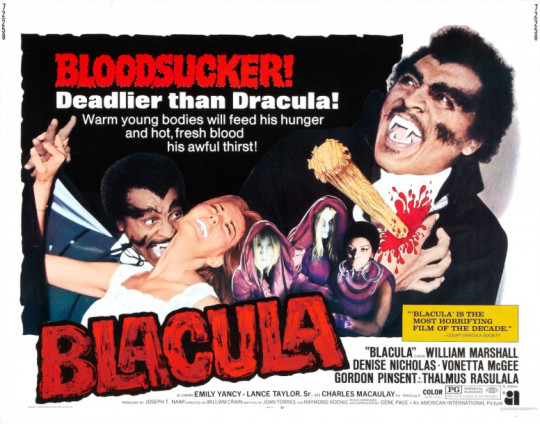
Blacula (1972) Summary
In 1780, Prince Mamuwalde (William Marshall) is sent by the elders of the Abani African nation to seek the help of Count Dracula (Charles Macaulay) in suppressing the slave trade. Dracula, instead, laughs at this request and insults Mamuwalde by making thinly veiled overtures about enslaving his wife, Luva (Vonetta McGee). After a scuffle with Dracula’s minions, Mamuwalde is transformed into a vampire. Dracula curses him with the name “Blacula” and imprisons him in a sealed coffin in a crypt hidden beneath the castle. Luva is also imprisoned in the crypt and left to die.
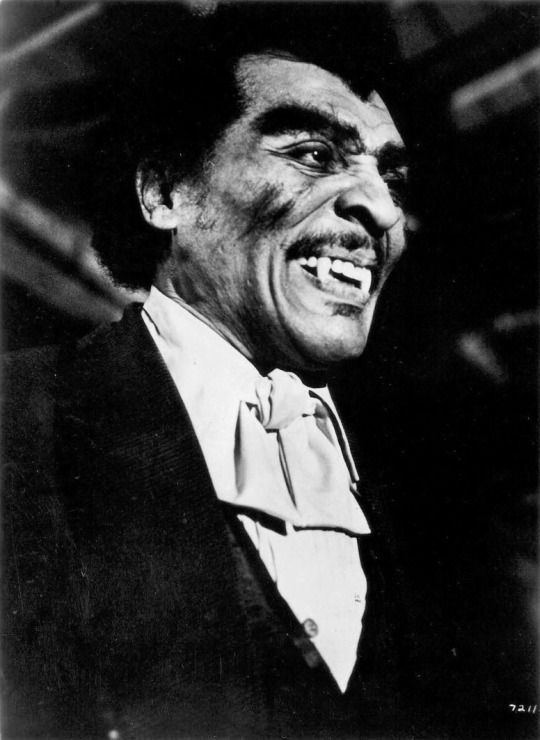
In 1972, the coffin is purchased as part of an estate by two homosexual interior decorators, Bobby McCoy (Ted Harris) and Billy Schaffer (Rick Metzler) and shipped to Los Angeles. Bobby and Billy open the coffin and become Prince Mamuwalde’s first victims. At the funeral home where Bobby McCoy’s body is laid, Mamuwalde spies on mourning friends Tina Williams (Vonetta McGee), her sister Michelle (Denise Nicholas), and Michelle’s boyfriend, Dr. Gordon Thomas (Thalmus Rasulala), a pathologist for the Los Angeles Police Department. Mamuwalde believes Tina is the reincarnation of his deceased wife, Luva. On close investigation of the corpse at the funeral home, Dr. Thomas notices oddities with Bobby McCoy’s death that he later concludes to be consistent with vampire folklore.
Prince Mamuwalde continues to kill and transform various people he encounters, as Tina begins to fall in love with him. Thomas, his colleague Lt. Peters (Gordon Pinsent), and Michelle follow the trail of murder victims and begin to suspect a vampire is responsible. After Thomas digs up Billy’s coffin, Billy’s corpse rises as a vampire and attacks Thomas, who fends him off and drives a stake through his heart. Thomas also finds a photo negative taken of Mamuwalde and Tina in which Mamuwalde is not visible. After killing one of the undead victims in the city morgue, Thomas and Peters track Mamuwalde to his hideout, the warehouse where Bobby McCoy and Billy Schaffer were first slain. They locate and defeat several vampires, but Mamuwalde manages to escape.

Mamuwalde lures Tina to his new hideout at a nearby chemical plant, while Thomas and a group of police officers pursue him. Mamuwalde dispatches several officers, but one of them accidentally shoots Tina fatally. To save her life, Mamuwalde transforms her into a vampire. One of the remaining policemen locates the coffin and alerts Peters. However, Peters inadvertently kills Tina with a stake, believing that Mamuwalde would be in the coffin instead. Devastated at losing her again, Mamuwalde tells Thomas and Peters there is no need to pursue him further, and willingly climbs the stairs to the roof where the morning sun destroys him.
youtube
DEVELOPMENT
The movie was put together by Joseph T. Naar, an agent who was looking to set himself up as a producer. Once he read the Blacula script, written by Joan Torres and Raymond Koenig, he gave it to Sam Arkoff, founder of the legendary B-movie company AIP, and it wasn’t a hard sell.
When William Crain was approached to direct Blacula, he had already done some episodic television, including The Mod Squad, and had previously studied filmmaking in Canada. Like a lot of African-American talent, Crain resisted blaxploitation assignments, and for him to take one on, it had to stand a chance of being a good movie. When he was offered Blacula, he leaped at the chance. “I was a youngster at the time,” he recalls. “I’m not sure how they found me, but they said they had this movie, this black vampire, and it turned out it was a legitimate project, so I really jumped on it. At the time, I was really happy to get that film; it just fell into place.”
When it came time to cast the title role, Crain says that he and Naar “went through every actor we thought could carry that role. Joe and I both had the idea that this guy should be regal, and because William Marshall had experience with Shakespeare—he had done Othello-we wanted that kind of presence. We called him, and he sat through the interview with a lot of style and poise. I was impressed. And he said OK, he’d go for it.”
This slideshow requires JavaScript.
Marshall recalled to the L.A. Times that he couldn’t believe he was being asked to play the part, but thought the project had possibilities. He also recalled having “damn near as many pages of criticism” for the script as there were pages. “Marshall didn’t like the whole blaxploitation movement that was going on; he made that very clear,” says David Sheldon, a former AIP executive. “He felt his contribution would uplift rather than demean.”
Marshall insisted that if he was to play Blacula, he had to be a dignified man, and he had to have approval over his dialogue; no way would Blacula speak jive. “I agreed with that, I didn’t want that either,” says Crain. “The guy should be a class act, not a buffoon, and that was the only way we could make this thing work. People would be sympathetic toward him because he has been cursed and taken away from his family.”
Blacula was shot in 28 days, and Naar remembers it costing about $500,000. Although the film was made on a tight, low budget schedule, Crain was determined to do the best job he could on his first movie. He recalls that AIP wanted him to get the movie done as quickly as possible, and one day, when they felt he wasn’t moving fast enough, the word came down from the company brass: “Listen, Crain, you’re not makin’ Gone With the Wind, just get the damn thing done!” Crain called his parents for advice, and remembers that his mother told him, “Go do the best you can.” So he stuck to his guns. “They wanted it fast, down and dirty,” he says. “They wanted me to just get through it, and I wouldn’t compromise.”
SOUNDTRACK/SCORE Blacula (1972) Gene Page
The movie also includes several musical performances from The Hues Corporation, who several years later had a huge hit with the disco classic “Rock the Boat.” Crain saw them perform in New York, and thought they’d be great for several scenes in a nightclub. “The Hughes Corporation actually stayed on longer than the script called for, because they were so good,” Crain says.
youtube
RELEASE/DISTRIBUTION/CONCLUSION
Blacula is also very professional-looking for a low-budget project, and Crain recalls that AIP put more support behind the movie as the production progressed. At first, they said no to the extra crewmembers and a dolly he wanted, but once they saw the dailies, more equipment was provided. “First thing, another camera crew showed up,” the director recalls. “Instead of using old Mitchell cameras, Panavisions started arriving!”
In Blacula, Marshall puts in a great performance without compromising his integrity as an actor. Not only was Marshall a huge talent, but at 6-feet-5 he was also a giant of a man. Crain and co. had to make sure some of his co-stars didn’t get too close to Marshall, lest they look like midgets in comparison. When people recall the actor, they often imitate his big, booming voice that could shake a room like a subwoofer. In Esquire’s review of Blacula, novelist Thomas Berger called Marshall “a magnificent figure of a man with a voice like a bass violin.” The
decision to play Blacula straight really paid off; he’s an intelligent, dignified vampire, not some fanged jive turkey in a cape. In its review of Blacula, The Hollywood Reporter stated, “With his stentorian tones and Shakespearean demeanor, Marshall carves a pillar of impeccable dignity and grace, thereby creating a fulcrum of sorts for the film’s relentless mayhem.”
“He was very convincing,” says Blacula cinematographer John M. Stephens. “Extremely convincing! I do remember certain times during the shoot getting a chill down my back.’
Besides his clear acting talents and professionalism, Marshall was a gentleman offstage as well. Most also recall him as being a very private man who didn’t let many into his personal life. “He was all business, all the way,” Crain says. “In terms of personal interaction, I never had a drink with him, I never did any fishing with him, we just never got together.” Despite his private nature, however, Marshall did keep his ranch home in Southern California open to young actors to come over for script readings.
Once it was released in summer 1972, reviews for Blacula were mixed. The New York Times wrote, “Anybody who goes to a vampire movie expecting sense is in for serious trouble, and Blacula offers less sense than most.” L.A. Times critic Kevin Thomas called it “a corny horror picture that’s lots longer on laughter than credibility.” But like many critics who reviewed the film, he gave Marshall’s performance high marks. “Marshall, the noted Othello interpreter, holds on to his dignity and holds the picture together pretty well besides.”
This slideshow requires JavaScript.
But critics be damned; the public responded strongly to Blacula. Both Crain and Marshall went to see the movie in theaters with regular paying audiences to witness their reactions. Crain went with a highschool friend (whom he had put in the film as an extra) to the Orpheum Theater in downtown LA. “We paid our admission and sat in the back,” Crain says. “People were rolling in the aisles. They were afraid in the places they should have been afraid, and they just had a really good time.”
The director says the success of Blacula “surprised everyone. It surprised me, too. I was a kid, so it was great just to be working. The only reservation I had was that I wasn’t sure if the African-American community was gonna accept it. Some people laughed when they heard I was going to shoot it, but I think it was pretty well-received.” In the book What It Is, What It Was, a history of the blaxploitation film, Marshall said, “I think the producers were quite surprised at how strong the positive response to the film was… Not for a moment did they think this was something that would become as meaningful to audiences as it did.”
Recollections aren’t totally clear on how much Blacula made at the box office, but Naar says it pulled in about $3 million, a great gross for the time—especially considering the film’s half million-dollar budget and that the average ticket price back then was less than two bucks. AIP took out trade ads celebrating the film’s success: “He’s Black. He’s Beautiful. He’s Boxoffice!”
Looking back on Blacula years later, Marshall told Jankiewicz, “Performing that role was rewarding in a number of ways, and I felt very good about it at the time. I still have to make up my mind whether to compliment it or run away from it! I guess it depends on how it strikes me,” he laughed.
“I believe Blacula was one of the best things that could have happened to William Marshall,” Crain offers. “The Shakespeare stuff comes and goes, there’s new people that come and do those plays, and once you do Othello, you’ve done it and that’s it. He knew he did a good job with Blacula, and it stayed with him for the rest of his life.”
Crain is also amazed that Blacula, currently available on DVD from MGM, is still remembered after all these years. “People ask me about it, and I say, ‘He just won’t die, will he?’ ” Crain is one of the founders of the Ethnic Minority Committee at the Directors Guild of America, and one day a coworker came up to him, shook his hand and told him he saw Blacula when he was a kid. “When we’d go to a screening, he’d always tell his friends, ‘This guy did Blacula, man, and it scared me!’”
Crain is certainly glad he made the film, but looking back, he also wishes he was more diplomatic when he was starting out.
This slideshow requires JavaScript.
CAST/CREW
Directed
William Crain
Produced
Samuel Z. Arkoff
Joseph T. Naar
Screenplay
Joan Torres
Raymond Koenig
Richard Glouner
William Marshall as Prince Mamuwalde / Blacula
Denise Nicholas as Michelle Williams
Vonetta McGee as Tina Williams / Luva
Gordon Pinsent as Lt. Jack Peters
Thalmus Rasulala as Dr. Gordon Thomas
Emily Yancy as Nancy
Lance Taylor Sr. as Swenson
Logan Field as Sergeant Barnes
Ted Harris as Bobby McCoy
Rick Metzler as Billy Schaffer
Ketty Lester as Juanita Jones / Taxi Girl
Charles Macaulay as Count Dracula
Ji-Tu Cumbuka as Skillet
Elisha Cook, Jr. as Sam
Eric Brotherson as Real Estate Agent
The Hues Corporation as themselves
Rick Hochman as The Young Hoch

Scream Blacula Scream (1973) Summary
After a dying Voodoo queen, Mama Loa, chooses an adopted apprentice, Lisa Fortier as her successor, her arrogant son and true heir, Willis, is outraged.
Seeking revenge, he buys the bones of Mamuwalde the vampire from the former shaman of the voodoo cult and uses voodoo to resurrect the vampire to do his bidding. However, while it brings Mamuwalde back to life, he bites Willis upon awakening. Willis now finds himself in a curse of his own doing: made into a vampire hungering for blood and a slave to the very creature he sought to control.
Meanwhile, Justin Carter, an ex-police officer with a large collection of acquired African antiquities and an interest in the occult, begins to investigate the murders caused by Mamuwalde and his growing vampire horde. Justin meets Mamuwalde at a party Justin hosts to display the African collection pieces before being moved to the University’s museum. They discuss the artifacts, unbeknown to anyone else, that were from the region of Africa Mamuwalde hails from, including pieces of jewelry once worn by his late wife Luva.
Mamuwalde also meets Justin’s girlfriend, Lisa Fortier, at the party and he discovers that Lisa is naturally adept at voodoo. Lisa discovers Mamuwalde’s true nature after a friend of hers, Gloria, falls victim to his bite and is resurrected as a vampire who nearly feeds on her, if not for Mamuwalde’s intervention. He later asks her for help to cure him of his vampire curse.
youtube
Justin, with the help of L.A.P.D. Lieutenant Harley Dunlop, pulls together several other cops to go to the Mamuwalde residence to investigate the recent deaths. While Lisa is performing the ritual to cure Mamuwalde, using a voodoo doll fashioned to look like him, Justin, Harley and their men raid the house, fighting against Blacula’s vampire minions which include several friends of theirs. Willis is killed during this scuffle. Justin manages to find Lisa and Mamuwalde and interrupts the ritual. Lisa refuses to help Mamuwalde after she witnesses him kill the other police officers in the house in a fit of rage.
After realizing that Lisa is no longer willing to help Mamuwalde, he rejects his human nature and decides to convert Justin into a vampire. Shouting he is only “Blacula”, Lisa stabs the prince’s voodoo doll with Justin’s arrows repeatedly. Blacula screams out in pain from Lisa’s voodoo doll attacks, but his final state is left ambiguous.
This slideshow requires JavaScript.
BACKSTORY
Arkoff was happy with how the movie performed, and of course it did well enough for AIP to make a sequel, Scream, Blacula, Scream!, released a year later. Marshall graciously returned, and the film also featured blaxploitation superstar Pam Grier. Torres and Koenig again wrote the screenplay, but Scream, Blacula, Scream! was helmed by a different director, Bob Kelljan, who had cut his teeth on AIP’s vampiric Count Yorga films.
“I didn’t do the sequel because I believe I pissed them off,” Crain admits. “We didn’t get along during the shoot. I was headstrong, young and brash. There were a lot of things they wanted that I thought were ridiculous, and things I wanted that I forced the issue on. We just didn’t get along, and when I heard they were going to do the sequel and they didn’t call me, I wasn’t upset.”
youtube
Most agreed that Scream, Blacula, Scream! didn’t capture the spark of the original. “It was in no sense of the word as interesting as the first one,” Marshall recalled to Fango writer Pat Jankiewicz. “I felt very good about Blacula, but I wasn’t quite as comfortable in the sequel.” He did feel, however, that Grier was “a marvelous addition…I liked her.”
This slideshow requires JavaScript.
CAST/CREW
Directed
Bob Kelljan
Produced
Joseph T. Naar
Written
Joan Torres
Raymond Koenig
Maurice Jules
William H. Marshall as Prince Mamuwalde / Blacula
Don Mitchell as Justin Carter
Pam Grier as Lisa Fortier
Michael Conrad as Lieutenant Harley Dunlop
Janee Michelle as Gloria
Lynn Moody as Denny
Barbara Rhoades as Elaine
Bernie Hamilton as Ragman
Richard Lawson as Willis Daniels
CREDITS/REFERENCES/SOURCES/BIBLIOGRAPHY
Starlog#255
Fangoria#264
Monsters of the Movies#30
DOUBLE FEATURE RETROSPECTIVE – Blacula (1972)/Scream Blacula Scream (1973) Blacula (1972) Summary In 1780, Prince Mamuwalde (William Marshall) is sent by the elders of the Abani African nation to seek the help of Count Dracula (Charles Macaulay) in suppressing the slave trade.
0 notes
Text
Inside Póster
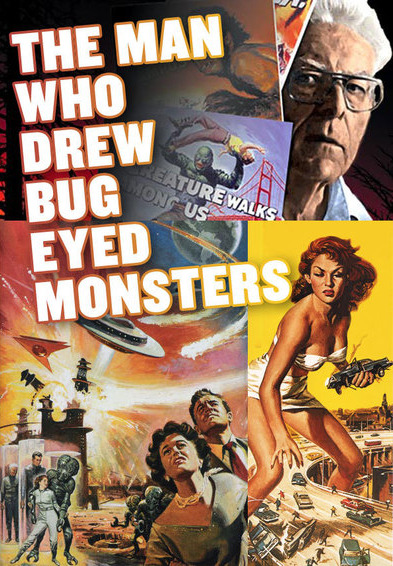
‘The Man who drew bug-eyed monsters’, Mel Bucklin, 1994, VO, SE en YouTube.
Majo y entretenido documental sobre el trabajo de Reynold Brown, uno de los más famosos artistas de carteles de cine de los años cincuenta y principios de los sesenta, con unas creaciones coloridas frente el clima social de la posguerra de la nación. Muestra decenas de sus carteles entrelazados con tráilers y segmentos de las películas para las cuales trabajó, como ’Attack of the 50 foot woman’, 'This island Earth’, 'Tarantula’ y 'The creature from the black lagoon’.
Cuenta con la presencia de Roger Corman y Samuel Z. Arkoff comentando el trabajo de Brown y discutiendo el arte de los carteles en un contexto histórico y social del arte.


Drew Struzan lleva pintando pósters desde hace más de tres décadas y de su mano han nacido carteles de films tan famosos como 'Una nueva esperanza', 'En busca del arca perdida' o 'Regreso al futuro', trabajos que se han convertido con el tiempo en algo más que un mero reclamo publicitario, son obras de arte estudiadas por universidades tan prestigiosas como la de Stanford; en este campo es un verdadero maestro, un artista capaz de condensar en pocos trazos la esencia de la historia que después veremos en el largometraje.
Struzan nació en Oregon City en 1947 y a los 18 años se matriculó en el Art Center College of Design de Los Ángeles. Comenzó ilustrando portadas de discos de artistas como los Beach Boys, Bee Gees, Roy Orbison o Black Sabbath y en 1976 emprendió su prolífica colaboración con el mundo del cine.
Sus carteles se caracterizan por su extremado realismo y siempre hay una o dos grandes figuras centrales presidiendo la obra y todos ellos poseen una intensa luminosidad casi mística y espiritual.
Struzan siempre trabajó a mano, pintando él mismo cada uno de sus trabajos pero con la llegada de la tecnología digital ese proceso artesanal fue cayendo en desuso y hoy en día está casi retirado. Sus últimos trabajos han sido 'Cómo entrenar a tu dragón 2', 'Batkid begins: The wish heard around the world', y realizará el cartel de 'Star Wars VII: El despertar de la Fuerza'.
‘Drew Struzan. An appreciation of an artist’, VO.
‘Drew Struzan. Making Blade Runner poster’, VO.
‘Drew Struzan. Conceiving and creating the Hellboy movie poster art’, VO.
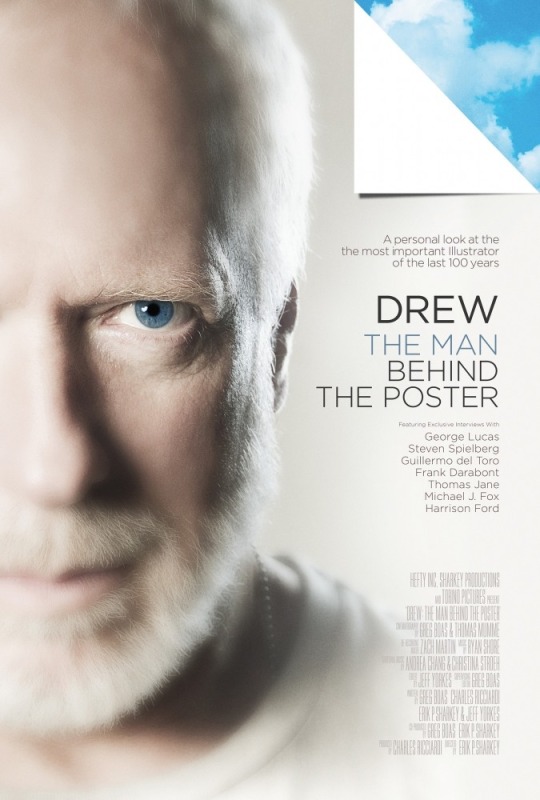
'Drew: The Man behind the poster', Erik Sharkey, 2013, VOSE.
Sobre el legendario dibujante de posters Drew Struzan, creador de trabajos tan populares como los carteles de 'Indiana Jones', 'Regreso al futuro' o 'Una nueva esperanza'.
A través de entrevistas con directores, artistas y críticos, el viaje cubre desde los inicios de Drew en publicidad y carátulas de discos hasta su reciente retiro, las historias detrás de sus creaciones más conocidas y la visión desde dentro de la industria y la profesión.
Con la participación de Drew Struzan, Harrison Ford, Michael J. Fox, George Lucas, Steven Spielberg, Guillermo del Toro, Frank Darabont, Steve Guttenberg, Bob Gale, Leonard Maltin, Michael E. Uslan, Thomas Jane, Sam Witwer, Joanna Cassidy y Alice Cooper entre otros.
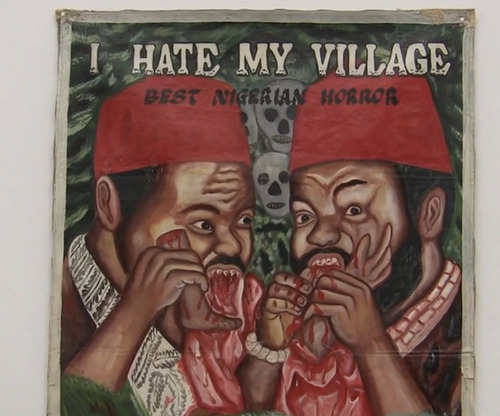
'Deadly and brutal: Filmplakate aus Ghana', Kunst+Film, 2011, VO.
Exposición en Munich de pósters de Ghana pintados a mano.
'Ghanaian movie posters', Cinefile Online, 2010, VO.
'24x36. A movie about movie posters', Kevin Burke, 2016, VO.
0 notes
Photo










ʀᴇᴘᴛɪʟɪᴄᴜs (1961)
#reptilicus#1961#sidney pink#ib melchior#mst3k#carl ottosen#bent mejding#denmark#copenhagen#film#cinema#gif#monster#monster movie#1960s#60s#aip#american international#american internation pictures#sam arkoff#james nicholson
198 notes
·
View notes
Photo

An Mini-Oral History of Maryjane (1968)
Kliph Nesteroff: You penned two scripts with Dick Gautier?
Peter Marshall: I did. Dick and I did Bye Bye Birdie together in Vegas. We became very close friends. We were together every day. I was struggling before Hollywood Squares, trying to make a buck. We started writing...
Dick Gautier: We were in Acapulco. We said, "Let's not just sit around. Let's write something."
Peter Marshall: We wrote a couple of TV things and then a friend of ours said, "Hey, I'm doing a movie on marijuana. Would you write the script?" So we gave him an outline. He said, "That's perfect. We're shooting in ten days." Didn't even have a script!
Dick Gautier: They said, "Here's what we want. We want a movie about marijuana." We said, "Okay." We started researching marijuana. We weren't smokers, but we started researching and discovered that the worst thing about it was that it was illegal.
Peter Marshall: We locked ourselves in an office and wrote this thing called Maryjane.
Dick Gautier: We wrote a beginning before the titles, where you see it being harvested and grown and cut into packages and sent to America. Then when the movie starts - we follow the five different packages. One goes to a housewife in Encino, another goes to a bank president, another here and another there. They didn't like it. They said, ‘No this is too literate and too boring.’ They had Fabian under contract and made him a high school teacher who starts selling it to kids.
Carl Gottlieb: I played a high school teacher in Maryjane. It was shot on the old Allied Artists lot. I'm in a scene with the high school faculty and the sheriff. We're discussing the marijuana problem at the school. Someone says, ‘You can't tell when these kids are high or not!’ I say, ‘You can tell. They act crazy and their eyes are funny.’ I was high myself. I was loaded when I shot that scene.
Peter Marshall: Fabian was in it and he said to the director, Maury Dexter, "Hey, can I change this?" He said, ‘Sure!’ We said, ‘No, hold it! You can't change that! That's the storyline!’ ‘Ah, don't worry about it.’ I never went back to the shoot. They destroyed you. The script had been real good, but they turned it into a terrible picture.
Dick Gautier: They almost dictated the thing to us. It was awful. We wrote it in eleven days.
Peter Marshall: It was a big hit!
Dick Gautier: A piece of shit.
Peter Marshall: It did very, very well and it's a terrible movie.
Carl Gottlieb: It was American International Pictures. Jim Nicholson and Sam Arkoff and a director named Maury Dexter who was a complete B-movie guy. He could shoot a movie in twelve days and he did.
Dick Gautier: The only scene in Maryjane that I like - I happen to be in. I’m the hippie in the jail cell with Fabian. I come in with a beard and all kinds of shit. I don't know if you remember it.
Kliph Nesteroff: No, I don't remember that. I'll have to watch it again.
Dick Gautier: No. Don't.
#AIP#american international pictures#american international#Dick Gautier#Carl Gottlieb#Peter Marshall#b movie#Maury Dexter#oral history
304 notes
·
View notes
Photo

AIP changes name of The Love Childen to Psych Out
#AIP#American International#Psych Out#Sam Arkoff#Jack Nicholson#Adam Roarke#Bruce Dern#Dean Stockwell#Susan Strasberg#Max Julien
10 notes
·
View notes